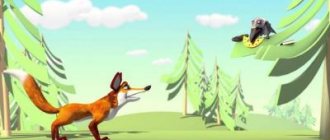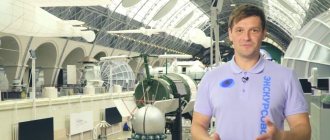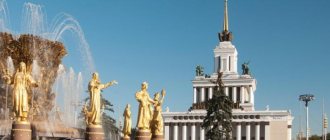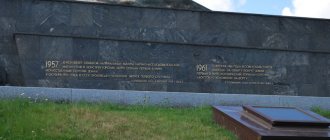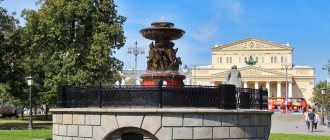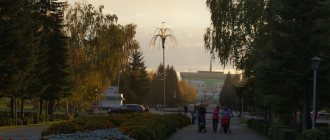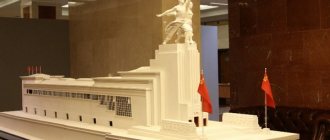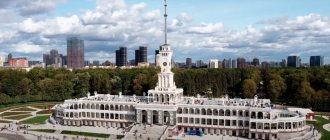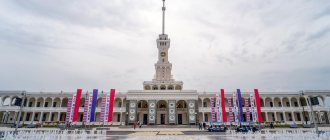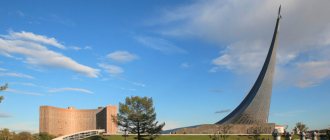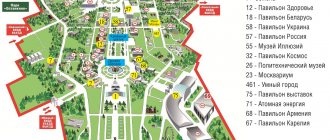The Friendship of Peoples fountain is one of the main symbols of the VDNKh complex. For more than 65 years, it has been welcoming visitors to the giant exhibition site, located on the Main Alley, 500 meters from the main entrance from Mira Avenue. The author, architect Konstantin Topuridze, was mercilessly criticized during his lifetime for the lack of monumentality, weight, decorativeness and even color in the composition. But now the golden figures of 16 girls standing around a bowl made in the shape of a 7-meter sheaf look like an elegant element that harmoniously fits into the VDNKh space. The neoclassical style in which the sculptures were created is reminiscent of the fountains of Peterhof rather than of Soviet art.
In April 2021, the fountain, whose perimeter length is 170 meters, opened after reconstruction, and now we can see “Friendship of Peoples” as visitors to the All-Union Exhibition Center saw it in the middle of the last century.
History of VDNH
The exhibition of achievements of the national economy began to be built in the second half of 1935. It was built for the 20th anniversary of Soviet power. And it had the name “All-Union Agricultural Exhibition”.
The pavilions were built hastily, but by June 1937, Ukraine, Belarus, and Turkmenistan were demonstrating their achievements in agriculture. It was not possible to complete the construction on time, it was extended and it was decided to build pavilions on the basis that they would last not 100 days, but 5 years. The grand opening took place on August 1, 1939. By this date, the majestic sculpture “Tractor Driver and Collective Farm Woman” had already appeared. It was already an entire exhibition city with an area of 136 hectares, about 200 buildings and 52 pavilions.
Now on the territory of the exhibition center more than 100 exhibitions in economic sectors are held, in which more than 70 countries of the world take part, congresses, concerts, and sporting events are held.
VDNH fountains: a great Soviet fairy tale
As soon as in our time the architectural ensemble of the VDNKh exhibition complex is not called: “reserve of socialism”, “factory of Soviet dreams”, “monument to unfulfilled dreams”, etc. At the same time, the architecture of the pavilions, fountains, and the general urban planning solution of the exhibition complex do not leave anyone indifferent.
For some, the Exhibition is a reason for acute nostalgia for the once “friendly family of fraternal Soviet republics.” For others, it is a reason to admire the work and talent of the best Soviet architects, engineers, sculptors and muralists, masters of decorative and applied arts, through whose efforts the unique architectural and landscape ensemble of VDNKh was created.
The territory of VDNKh represents a true abundance of architectural monuments, which not only citizens of the former USSR, but also numerous foreign guests still come to see. The most significant objects The exhibitions, created over several decades, are a kind of reference book containing invaluable visual information about the stylistic directions and architectural trends that prevailed in the USSR at different times. Among the masterpieces of VDNKh, it is usually customary to mention the monument to V. Mukhina “Worker and Collective Farm Woman” (architect B. Iofan), the Main Pavilion of VDNH (architect G. Shchuko, E. Stolyarov), the pavilion of the Ukrainian SSR (modern view - architect D. Chechulin), pavilion of the Uzbek SSR (modern view - architect S. Polupanov), pavilion “Mechanization and electrification of agriculture of the USSR (1939), since 1956 - “Mechanical Engineering”, since 1963 - pavilion “Space” ( architects V. Andreev, I. Taranov, chief designer M. Limanovsky, designer G. Gordon).
A special place in this list is occupied by the VDNKh fountains, among which the greatest interest is “Friendship of the Peoples of the USSR”, “Stone Flower”, and Golden Ear.” These hydraulic structures, which have the status of monuments of federal significance, will be discussed in an article prepared by Alexander Borisovich MAZIKOV, network maintenance engineer at the Department of Architecture and Urban Development at VDNKh.
Fig.1
Among the hydraulic structures of the Exhibition, fountains and water decorative complexes of the pavilions occupy a special place. Since the opening of the All-Union Agricultural Exhibition (VSKhV) in 1939, they have given the territory a special charm. Even though those fountains were technically simple, this drawback was significantly outweighed by their artistic value. That is why, at that time and now, fountains are as much a historical and cultural attraction of the Exhibition as the pavilions themselves.
Unfortunately, the fountains of 1939–1948 Due to a number of objective reasons, most of them have not survived to this day, but today we still have the opportunity to judge the appearance of some of them from the available photographs.
Fig.2
In Fig. 1, 2 The main fountain on the “Collective Farms Square”. In addition to the most powerful fountain jets for that time, it had changing night lighting.
Rice. 3. Fountains of VSKhV on the diagram of 1939.
Rice. 4. Fountain “Spike”, 1939
Rice. 5. This should have been the fountain in front of the Transcaucasian Federation pavilion in one of the project options
After the decision was made to provide all Union republics with their own pavilions, this pavilion was rebuilt (“the watchtower” was demolished, the facades were changed) and received a completely different appearance and name (Fig. 5). Two decorative fountains were located behind the colonnade of the facade.
Fig.6. Pavilion of the Georgian SSR
Rice. 7. Decorative fountains were built at the entrance to the pavilion of the Azerbaijan SSR
Rice. 8. General view of the pavilion of the Azerbaijan SSR
Pavilion "Volga Region", later - pav. No. 15 “Radio electronics and communications”, until 1954 had on its façade a working model of the Kuibyshev hydroelectric power station (Fig. 9).
Rice. 9. Pavilion "Volga Region"
Very impressive decorative fountains were installed on the facade of the Kyrgyzstan pavilion (Fig. 10) and the area in front of the Glavkonserv pavilion (Fig. 11).
Rice. 10. Decorative fountains of the gallery of the main facade of the pav. "Kirghiz SSR", 1939
Rice. 11. Pavilion "Glavkonserv"
Rice. 12. The pool with a sculptural composition near the Far East pavilion was unusually beautiful.
In no case should you ignore the fountain of the Uzbek SSR pavilion. In 1939, it was a one-story building with a U-shaped configuration in plan, with its base facing “Kolkhoz Square.” In front of the façade of the pavilion there was a light openwork gazebo-rotunda, designed in national colors, standing in the middle of the cour d'honneur above the round pool of the fountain (Fig. 13).
Rice. 13. Pavilion of the Uzbek SSR
In addition, there were fountains in the pavilions of the Byelorussian SSR (Fig. 14) and the Tatar Autonomous Soviet Socialist Republic (Fig. 15), as well as near the “Peat” pavilion (Fig. 16). There is a decorative fountain at pavilion No. 56 “Veterinary Medicine” (Fig. 17).
Rice. 14. Pavilion of the Belarusian SSR
Rice. 15. Pavilion of the Tatar ASSR
Rice. 16. Pavilion “Peat”
Rice. 17. Pavilion “Veterinary Medicine”
The cafe-dining room “Chaikhana”, located behind the pavilion of the Uzbek SSR, was very popular among visitors to the pre-war Exhibition. This was greatly facilitated by the presence of a small pool with a fountain in its central part. This tradition was preserved in its subsequent versions.
Not far away was the “Oriental Restaurant”, on the site of which the “Uzbek Teahouse” restaurant appeared in 1954. Many people are mistaken that the restaurant “Uzbek teahouse” and “Chaikhana” are one and the same. In 1954, on the site of the demolished Chaikhana cafe, the Glavkhladprom pavilion was built. At the same time, the “Oriental Restaurant” was reconstructed and became known as the “Uzbek Teahouse”, and later – the “Tashkent” restaurant. They existed almost until the end of the 1980s, when due to disrepair they had to be closed and then demolished.
Rice. 18. "Teahouse"
In addition to those described, there were several other small fountains on the territory of the All-Russian Agricultural Exhibition, but their descriptions and photographs have not been preserved. Now it is difficult to imagine what the fate of the fountains and decorative complexes of those years would have been, but the Great Patriotic War changed everything.
The All-Union Agricultural Exhibition was able to receive visitors after the end of the war only in 1954. By this time, an almost new Exhibition was designed and built, which preserved all the best from the pre-war All-Union Agricultural Exhibition. The radical reconstruction affected absolutely all aspects of its life and activities, while fully preserving the layout of the territory and the architectural style of Stalinist neoclassicism, as well as the historical principles of displaying the country's achievements.
How did visitors see the new All-Union Agricultural Exhibition in September 1954?
From the editor
The history of VSKhV is full of dramatic and even tragic pages. Design work on the organization and development of the territory of the future Exhibition began back in 1937 after the adoption of the corresponding resolution of the Council of People's Commissars of the USSR and the Central Committee of the All-Union Communist Party (Bolsheviks) signed by I.V. Stalin and V.M. Molotov. In the same year, the first wave of arrests swept through the People's Commissariat of Agriculture, which also affected members of the exhibition committee. Among others, the People's Commissar of Agriculture and the Chairman of the Main Exhibition Committee M.A. were arrested. Chernov, and in 1938 - construction manager I.E. Korostashevsky. All of them were shot...
But the chief architect of VSKhV V.K. Oltarzhevsky “got off” with a term of imprisonment in a camp in Vorkuta and was released in 1943.
After the opening of the Exhibition in 1939, many of the architects who participated in the creation of its ensemble would be awarded high government awards. Among the recipients is the chief architect of the All-Russian Agricultural Exhibition S.E. Chernyshev (Order of Lenin); architects K.S. Alabyan, V.S. Andreev, A.A. Tatius (Order of the Red Banner of Labor); V.G. Golfreich S.N. Polupanov, D.N. Chechulin (Order of the Badge of Honor).
During the Great Patriotic War (VSKhV was closed on July 1, 1941), some empty pavilions were converted into workshops, warehouses, and barracks. According to the memoirs of S.A. Lagodsky, a former state security officer, the area adjacent to the cascade of artificial ponds was used to train intelligence officers.
During the entire war, not a single bomb fell on the territory of the All-Russian Agricultural Exhibition. However, some of the pavilions were destroyed by time, as they were built as temporary structures for work in the summer. Others, left without proper supervision and protection, were simply plundered. In addition, exhibits that were evacuated were not subject to re-transportation. All this required a thorough reconstruction and restructuring of many Exhibition objects in the post-war period.
"Friendship of the Peoples of the USSR"
The “Friendship of the Peoples of the USSR” fountain, one of the main symbols of the era of socialism, was built on “Kolkhoz Square” for the re-opening of the All-Russian Agricultural Exhibition in 1954. It was designed in the best traditions of fountain art of the 17th–18th centuries. and erected under the direction of architects K.T. Topuridze and G.D. Konstantinovsky, engineer V.I. Klyavina, and teams of sculptors: Z.V. Bazhenova, A.I. Tenets, I.M. Chaikova, Z.V. Ryleeva and V.P. Gavrilova.
Rice. 19. This is what the “Friendship of Peoples” fountain looked like in 1954.
Before starting to describe the fountain “Friendship of the Peoples of the USSR”, it is necessary to return to the post-war period when the revival of the All-Union Agricultural Exhibition began.
In 1948, a decision was made to resume the activities of the All-Russian Agricultural Exhibition in order to demonstrate the progress of the country’s restoration after the Great Patriotic War, as well as, as in the pre-war period, to disseminate scientific achievements in sectors of the socialist economy, exchange best practices and train highly qualified specialists. The existing Exhibition complex, dilapidated over many years of neglect during the war, was not suitable for solving these problems. What was needed was an example of a model city of the future, to which the country's leadership was leading the masses.
When designing such a city, it was decided to build a new one on the site of the Main Fountain of 1939. He was supposed to personify the unity of the entire people during the construction of communism and evoke associations with the abundance that awaits him in the near future. “Sheaf” is the code name given to this project.
Rice. 20. Relative position of the Main fountains of 1939 and 1954.
The project of a new, grandiose fountain, created by famous architects K.T. Topuridze and G.D. Konstantinovsky, provided for the erection of a sheaf of agricultural crops on a round base, symbolizing the power of the unity of the peoples inhabiting the USSR. A sculptural group of 16 girls represented the Union republics of the country. 16 bronze still lifes surrounding the bowl of the fountain, judging by the sketches for the project (Fig. 21), were supposed to symbolize the agricultural achievements of the republics that were part of the USSR. It was planned to apply the names of the republics on the granite base of the still lifes (Fig. 22). 16 pairs of sturgeons and 16 groups of geese near the bronze still lifes were to be associated with the successes of the country's fisheries and poultry farming, respectively. As a result, the fountain project turned out to be very overloaded not only ideologically, but also architecturally.
Rice. 21. Sketch of a republican still life. Copied from the preliminary design of 1952.
Rice. 22. Sketch of the sculptural composition of the Main Fountain “Sheaf”. Copied from the preliminary design of 1952.
The solution to the problem of a new approach to organizing the activities of the All-Russian Agricultural Exhibition was the new layout of the Exhibition, which was finally formed by 1952. Instead of the USSR pavilion of 1939, a square appeared that had the configuration of an elongated octagon. The second fountain organically fit into its contours and became a decoration for the “Collective Farms Square”. Apparently this is how the idea of dividing the “Sheaf” project into the “Friendship of the Peoples of the USSR” and “Stone Flower” fountains came about.
The central golden sheaf and the figures of the girls organically fit into the octagon of the appeared square, and in the “Stone Flower”, inspired by the tales of P.P. Bazhov, the surroundings of bronze still lifes, geese and sturgeons are perfectly intertwined. At the same time, the differences in the construction part of the structure and the fountain equipment were not very significant.
The fountain complexes of the Main Alley are historical and cultural monuments, delighting us with their jets and architectural and decorative solutions to this day.
A golden sheaf of wheat on a stepped granite base, erected in the center of a large 8-sided bowl, surrounds 16 figures of girls, according to the number of republics of the USSR that existed at that time. The entire sculptural part of the composition is covered with gold leaf. The principle of the arrangement of the figures is not completely, but to a greater extent corresponds to the population of the union republics as of 1954. After the transformation of the Karelo-Finnish SSR into the Karelian Autonomous Soviet Socialist Republic within the RSFSR in 1956, 15 union republics remained, but the number of figures in the VDNKh fountain does not change become.
The characteristics of the fountain at the time of its construction were stunning, and its beauty defied description. The bowl of the fountain had a volume of about 4 thousand m3, the number of jet nozzles was about 1 thousand, the height of the water jets reached 24 m above the top point of the fountain, these are the so-called “ceremonial jets”. The number of jet patterns is 6 main and 25 intermediate. The central sculptural group is flanked by two decorative jet fountains with sculptural images of fish. They are made of copper sheets using the hammering method. Sculptures of fish organically complemented the monumental composition in the center of the bowl. The fountain ensemble was completed by 4 pairs of decorative sculptures of dolphins. A longitudinal stream shoots out of each mouth. The unusually beautiful decorative night lighting (about 250 spotlights were installed for this purpose) changed 16 times within an hour. The change in colors was associated with a change in jet patterns. This can be seen even in black and white photography.
Rice. 23. Arrangement of figures
Color photographs of the fountain emphasize its bright figurative expressiveness and unusualness. The fountain looks great when lit at night.
Rice. 24
The central part of the fountain, on which the decorative sculptural composition rests, has a height of 5.56 m in the middle. From the middle part, the height of the ring collector (machine room) cascades down to 3.5 m. In plan, it has an oval configuration with dimensions at the bottom level - 21.3 m and 16.8 m. The central part is built of reinforced concrete, the foundation is a solid reinforced concrete slab with a thickness of 35 cm to 45 cm. A system of reinforced concrete columns supports a stepped reinforced concrete floor.
The machine room contains 8 electrically driven pumping units, shut-off valves for the hydraulic system, electrical distribution cabinets, communication devices, etc. In the ceiling of the central part of the fountain there are two ring-shaped belts glazed with stalinite, which serve to illuminate the fountain jets. The outer part of the machine room is surrounded by a water intake manifold with an internal cross-section of 1.67 x 3.1 m, which serves as a coarse water filter and settling tank. In the ceiling of the gallery there are 16 glazed wells for illuminating the jets. In Fig. 25 and 26 show a plan and vertical section of the fountain.
Rice. 25. Fountain plan
Rice. 26. Vertical section of the fountain “Friendship of the Peoples of the USSR”
The machine room is connected by a passage underground gallery with a pav. No. 71, where the supply transformer substation (TS) is located and the fountain control panel is located. The gallery contains a water main, a heating main, power supply cables and control system cables, as well as a communication cable. The total length of the collector is about 125 m.
The passage section of the section from the pump station to the intermediate hatch is 2.2x2.3 m with a length of 55 m, and from the intermediate hatch to the transformer substation is 1.6x2.0 m with a length of 70 m. Waterproofing is provided along the outer perimeter of the gallery.
Rice. 27. Turbine room and exit from the machine room to the passage gallery
By 2000, the electrical devices for illuminating the jets, located in the turbine room of the fountain, were so physically and morally outdated and dilapidated that they had to be dismantled. To illuminate the “Friendship of the Peoples of the USSR” and “Stone Flower” fountains (as a half-measure), without changing their historical appearance, illumination was organized in 2013 by the All-Russian Exhibition Center service organization using LED spotlights. Photos comparing the backlights are given below in the description of the “Stone Flower” fountain.
Rice. 28. Passage gallery
The repair of the fountain “Friendship of the Peoples of the USSR” was carried out by the State Budgetary Institution “Gormost” in 2005–2006. Due to the fact that these works were not restoration, the repairs were carried out without a project that would justify the use of technologies used in the restoration of objects. However, he allowed the continued operation of this hydraulic structure. Unfortunately, after the completion of the repair, due to the above reasons, many shortcomings were discovered that were eliminated during subsequent operation.
Rice. 29. Fountain “Friendship of the Peoples of the USSR” modern view
From the editor
The “Friendship of the Peoples of the USSR” fountain was built on the site where the area for holding public events was originally planned. The fountain became another architectural masterpiece on the territory of VDNKh (at that time - VSKhV).
In the center of the sculptural composition of the fountain there is a giant sheaf made up of agricultural crops that were considered the main ones in the USSR at that time: wheat, sunflower and hemp. By the way, hemp has been cultivated in Rus' since the 9th century. and along with flax they were used for the manufacture of various fabrics, as well as in the manufacture of ropes and ropes. In 1928, Soviet Russia ranked first in the world in terms of acreage devoted to hemp.
Initially, the authors of the fountain project proposed decorating the sculptures with polychrome smalt, but this idea did not find support “at the top.” As a result, the entire sculptural composition was covered with gold leaf.
Representatives of the titular peoples of the Union republics of the USSR acted as models for the female sculptures. History has preserved the names of some of them. These are the Estonian ballerina Virve Kiple-Parsadanyan, the pianist from Turkmenistan Gozel Annamamedova and the wife of the poet Mikhail Svetlov, the beautiful Georgian Rodam Amirejibi.
The main accent function of the sculptural composition is the figure of a girl, symbolizing Russia. She faces the Main Pavilion and clutches a bunch of ears of wheat. To the right and left of her are the “Slavic sisters”: Ukraine and Belarus.
"Stone Flower"
The “Stone Flower” fountain (Fig. 30) was created by sculptor P. Dobrynin. The basis for the fountain was the design of Soviet architects K.T. Topuridze and G.K. Konstantinovsky. The “Stone Flower” was built, like the “Friendship of the Peoples of the USSR” fountain, in the same 1954. Some elements of the fountain were made in the workshops of the USSR Academy of Arts - such care and attention was paid to its construction!
Fig.30
The fountain is located on the longitudinal axis of the “Collective Farms Square” in front of the Ukrainian pavilion, almost in the same place where the Main fountain of the All-Russian Agricultural Exhibition was in 1939. The 100-meter bowl of the fountain consists of two interconnected containers (Fig. 31).
Rice. 31. Plan of the fountain “Stone Flower”
The “Stone Flower” fountain is a huge 8-meter-tall opening bud made of shining smalt, a symbol of awakening life. It is raised on a multi-tiered pedestal, the upper ledge of which is decorated with stylized druses of jasper, malachite, lapis lazuli and orlets, and the two lower ones are trimmed with torn granite. The side of the lower ledge is decorated with gold scales, made in a mosaic of yellow cantarelle on a silver base. As in the architecture of the “Friendship of the Peoples of the USSR” fountain, the “Stone Flower” repeats the symbolic number 16: on the outer wall of the central ledge there are 16 cast iron shells with colored mosaic inserts between them, and above the shells there are 16 mosaic decorative flowers. The fountain bowl is decorated with 16 decorative still lifes, the sides of the bowl are lined with red polished granite, etc.
The bud of a blossoming flower itself is lined with smalt, as are the semi-precious stones surrounding it (Fig. 32). This beauty, as if by magic, appeared before us from the tales of P.P. Bazhova. The decorative elements of the fountain, unique in their beauty, as well as its framing: sturgeons on the mirror of the fountain bowl, geese (Fig. 33), bronze still lifes of 4 types, emphasize the atmosphere of fabulousness.
Rice. 32
The jets of the fountain in different patterns reach a height of 20 m. On 4 sides of the pedestal there are 4 more ring groups of fountains. On the inside of the sides of the fountain bowl, under the still lifes, there are 16 fountains in the form of bronze figures of geese. Spotlights were installed in the niches located inside the base of the bronze still lifes to illuminate the jets of the fountain.
Rice. 33
The entrance to the gallery (Fig. 34), leading to the fountain's machine room, is located between the bowl and pavilion No. 58. Next to the entrance there is an underground transformer substation of the fountain. The passage section of the gallery, like that of the “Friendship of the Peoples of the USSR” fountain, is 2.2x2.3 m with a length of 24.5 m. In the middle part of the gallery, in the place where it passes under the bottom of the fountain bowl, the height of the passage section is reduced to 1 .6 m.
Rice. 34
Until 2015, the entrances to the gallery and the transformer substation were made in the form of non-permanent buildings, the basis of which was a metal frame covered with a metal sheet. The entrance to the intermediate hatch of the “Friendship of the Peoples of the USSR” fountain was designed in a similar way. Since the appearance of the hatches was dissonant with the surrounding buildings and landscape, it was decided to replace them.
Rice. 35. The design of the entrances and ventilation shafts was considered the most successful, after which it was implemented in 2021.
In the machine room of the fountain, located, like the “Friendship of the Peoples of the USSR” fountain, under the central part of the main sculptural composition, there is pumping equipment, pipelines with shut-off valves and automatic control of the jets, night lighting and ventilation systems, etc. In 2021, In the machine room of the fountain one could still see not only the main fountain equipment with an electrical control cabinet, but also modern spotlights for the night illumination of the jets (Fig. 36). For comparison, here is a photo with a lighting system from 1954 (Fig. 37).
Rice. 36
Rice. 37
When operating simultaneously, 11 pumping units in the turbine hall are capable of spewing up to 2 thousand liters of water per second into the air. The control system allows you to create 6 different patterns using changing combinations of jets. The volume of the fountain bowl is about 3 thousand m³. The total number of jets in the fountain is 1 thousand.
Rice. 38
Like any historical object, the Exhibition has its own myths and legends. One of the legends says that composer D.D. Shostakovich at the opening of the All-Russian Agricultural Exhibition in 1954. wrote a “Festive Overture” for the “Stone Flower” fountain, under which the patterns of the jets and their illumination changed. This is not entirely true.
In fact, the overture was written for the 37th anniversary of the Great October Socialist Revolution. But during the operation of the fountain it actually sounded. The legend remains a legend, but you must admit that with decorative lighting at night, the “Stone Flower” is no less beautiful than in the rays of the bright sun.
Emergency work carried out on the fountain in 2014 made it possible to continue its operation. However, existing problems were only partially resolved. Below are photos that give an idea of the condition of the fountain in early summer 2021.
Fig.39. Machine room in 2021
Rice. 40. Decorative sculptural groups and still lifes after emergency work in 2014.
Rice. 41. State of the central composition
Rice. 42. Condition of the base and water intake collector
Rice. 43. Condition of the sides of the bowl
Rice. 44. Condition of the joint of the bowls
Rice. 45. General view. 2021
Having worked for more than 50 years and completely used up its technical resource, the fountain “reached” until 2021, when its overhaul and full-scale restoration began.
From the editor
The artistic image of the monumental composition of the “Stone Flower” fountain is inspired by the plot of the famous tale by P.P. Bazhov "Mistress of the Copper Mountain". At the time when work was underway on the fountain project, the work of P.P. Bazhov was extremely popular in the USSR. In 1946, the tale “The Mistress of the Copper Mountain” was filmed (dir. A.L. Ptushko), and in 1954 the ballet “The Stone Flower” to the music of S.S. premiered at the Bolshoi Theater. Prokofiev.
The perimeter of the pool bowl is decorated with “tables” with sculptural bronze still lifes. Initially, it was assumed that each of the 16 still lifes (according to the number of union republics of the USSR) would depict those samples of agricultural products for which one or another republic was famous. However, later this idea was abandoned and limited to 4 types of still lifes, which were simply replicated.
Since the working fountain was accompanied by music from the “Festive Overture” by D.D. Shostakovich, and in the dark - decorative lighting, it is believed that the “Stone Flower” is the first light and music fountain in the USSR.
"Golden Ear"
“Golden Ear” is one of the oldest fountains of the All-Russian Agricultural Exhibition. In 1939, it was called “The Spike on the Pond of the All-Russian Agricultural Exhibition,” and received the name “Golden Spike” only in 1954. The idea of building the “Spike” fountain belonged to V. Oltarzhevsky, who was the chief architect of the Exhibition at that time. “Spike” was realized through the efforts of the sculptor P.I. Dobrynin, engineers B. Novikov and S. Strashkevich. The fountain personified the idea of the Exhibition itself. The “spike” was a symbol of fertility and prosperity, and the ladder should be associated with the path along which the country followed to achieve it (Fig. 46).
Rice. 46. Sketch for the fountain project
The design for the “Spike” fountain was determined to be in the central part of pond No. 3, through which the main architectural axis of the Exhibition under construction passed. Its location became dominant in the planning of the dammed part of the Exhibition territory and the placement of capital buildings on it (Fig. 47). For this purpose, the contour of the shoreline of the pond was slightly changed, it was strengthened, the road and path network was laid out accordingly, and a park lighting system was organized.
Rice. 47
Initially, at the opening of the All-Russian Agricultural Exhibition in 1939, the Kolos fountain was covered with copper sheets minted using the hammering method (Fig. 48). Over time, under the influence of the external environment, the sheets darkened, and this gave the entire fountain a gloomy appearance. To suppress this effect, the surface was partially painted “gold”. The machine room of the pumping station, together with the supply transformer substation, is located behind dam No. 3, separating ponds No. 3 and No. 4. Then they were called the Upper and Lower Ponds, respectively.
Rice. 48
Due to the fact that a rural hydroelectric power station was installed at dam No. 3, through which a significant water flow passed, to maintain the water level in pond No. 3, an internal system was provided in the fountain pumping station, which ensured the return of water from pond No. 4 to the Upper Pond at non-working fountain. A system for draining water from pond No. 3 was also provided, because The project stipulated the possibility of draining the pond in the winter.
The height of the Kolos fountain was 16 m. The jets rose to a height of 25 m and were, as it were, a continuation of the spines of the ear. The fountain emitted 126 jets through nozzles with a diameter of 10 mm to 29 mm.
In the panorama of pond No. 3, taken in 1939 (Fig. 48), the old Kolos fountain is visible. It worked until the start of the war, and then stood idle until 1948. In 1949, due to the dilapidation of the structure, it had to be dismantled.
1954 presented the Exhibition with a new fountain, now known as the “Golden Ear”. The project of the “Golden Ear” (Fig. 49) was carried out by the authors of the fountains “Friendship of the Peoples of the USSR” and “Stone Flower” - architect K. Topuridze and sculptor P. Dobrynin. This project, like the “big brothers”, provided for decorative dynamic lighting, but this idea was not implemented.
Rice. 49
During the construction of the Golden Spike fountain, an old pumping station combined with a transformer substation was used. The pressure main pipes from the pumping station to the foundation of the fountain, 128 m long, were replaced. Two pumping units with a capacity of 200 l/sec were installed at the pumping station. The return of water from pond No. 4 to pond No. 3 was carried out by a pumping station through a fountain.
The main load-bearing element of the new fountain was a metal pipe with a diameter of 1220 mm (Fig. 50). Inside the pipe there are pipelines with shut-off valves that supply water to the fountain part. From the outside, the pipe is surrounded by a reinforced concrete part of the ear, which is supported by three horns of plenty.
Rice. 50. Section of the fountain “Golden Ear”
The “grains” of the “Golden Ear” fountain, as well as the decorative part of the base of the sculptural composition in the form of acanthus leaves and cornucopias, are made in gold mosaic (cantarelle and mosaic colored smalt) on a reinforced concrete thin-walled frame. The reinforced concrete base of the Golden Spike fountain was lined with red polished granite.
Rice. 51. This is how the “Golden Spike” fountain was seen by participants of the All-Union Agricultural Exhibition and its visitors in 1954.
The peculiarity of this structure is that the fountain itself is located on a foundation resting on piles driven into the bottom of the pond and not connected to the shoreline. The fountain's pumping station is located at a considerable distance from the fountain itself. All this can be seen on the site plan (Fig. 47).
As the years passed, the “Golden Spike” fountain repeated the fate of its brothers at the Exhibition, but in a more unsightly form. It ceased to function as a fountain by the early 1990s. The pumping station was maintained in working condition for quite a long time. The last test run of the pumps was carried out in the early 2000s. By this time, almost the entire dammed part of the Exhibition had fallen into complete disrepair.
This is what the fountain looked like, which the author had to inspect in the fall of 2012 (Fig. 52-54).
Rice. 52
Rice. 53
Rice. 54
Of course, an object of historical and cultural heritage of federal significance should not exist in this form. Therefore, in 2014, when carrying out work to improve the territory, a number of emergency measures were implemented at the Golden Spike fountain. Visually, the appearance of the fountain has improved. However, the fountain's pipelines and shut-off valves had completely lost their functionality and therefore its operation was imitated by three floating fountains installed in close proximity to the base (Fig. 55). However, by the beginning of 2021, new damage appeared on the “body” of the fountain and its base (Fig. 56).
Rice. 55
Rice. 56
Also in 2014, during emergency response work, representatives assessed the technical condition of the Golden Ear fountain. According to the results of this assessment, the following elements of the fountain were subject to dismantling and replacement: the foundation, the central supporting pipe Ø 1200 mm, the fountain cladding structures made of thin-walled concrete, the internal distribution of water supply in the fountain, the main water supply pipelines from the pumping station to the fountain, etc. To carry out such work, it was necessary to prepare a project for the restoration of the fountain.
The project was prepared and passed the appropriate examination and approval. Work on the restoration of the fountain began in the summer of 2017.
From the editor
Initially, the fountain was assembled from 308 decorative elements. At the end of July 2021, 110 of them had been dismantled. The preservation of smalt on removed decorative parts was 5–20%. The state of preservation of the red polished granite on the base is 70–80%. According to the head of the Moscow Department of Cultural Heritage A. Emelyanov, “the surviving smalt will be preserved, all losses of mosaic decor will be replenished.”
It remains to add that today, before our eyes, the architectural ensemble of VDNKh, including the famous fountains, is experiencing a rebirth. Not only the restoration of monuments of our history and architecture is underway, but also the restoration of what was lost, a deep reconstruction and modernization of VDNKh's engineering networks. It is very good that this process fully affected the Exhibition fountains.
The fact that, after decades of stagnation, the restoration of the unique exhibition complex has finally gotten off the ground is the undoubted merit of the current leadership of Moscow and, above all, the mayor of the city, S.S. Sobyanin. God grant that everything turns out as planned and, by the time the restoration work is completed, the updated Exhibition in all its glory will be able to please Muscovites and numerous guests of the capital.
The history of the appearance of the “Friendship of Peoples” fountain
This miracle of architectural thought appeared on the territory of the complex in 1954 on the modern central alley called Friendship of Peoples. Previously, there was a children's cafe at this place and there were several pavilions and the square was called Kolkhoznaya.
The project was developed by two architects: G.D. Konstantinovsky. and Toluridze K. The hydraulic engineering part was handled by V.I. Klyavin, and the electrical engineering part was handled by the entire design office “Mossvetproekt”.
At the design and construction stage, the fountain was called the “Main Fountain”, and during construction it was called the “Golden Sheaf”. It received its modern name only before its opening.
When designing, it was planned to install a stone flower in the middle of 16 female figures (another majestic and popular VDNKh fountain). But once again at the art council, they decided to separate the objects and separate them into two separate fountains.
Night play of colors
The system of jets rises in the central part of the fountain to 20 meters. And although in recent years the pumping station has not been turned on at full capacity (reconstruction is expected), the spectacle is still amazing. The station with pumps is located underground and connected to pavilion 71 by a tunnel.
Every hour and a half, the jet patterns change automatically. And in the evening this beauty is also illuminated by 250 spotlights. The result is an unimaginable extravaganza of light and water, which cannot be described in words, but can only be seen.
On a summer day, the sun plays merrily on the golden figurines of girls, decorating this man-made embodiment of friendship of all nations. Many consider this composition the most striking monument of the Soviet era. It reminds new generations of how their ancestors wanted to live in peace, and how they rallied after the hardships of fighting Nazi Germany. But such a victory, indeed, became possible thanks to mutual assistance, friendship and brotherly love between people of different nationalities.
Symbol of the Soviet era
The “Friendship of Peoples” fountain stretches 170 meters along its perimeter, with an internal diameter of 56 meters. This is an octagonal structure with a total area of 3.5 thousand square meters. m.
In the middle of the composition, jets rise 20 meters high. In 1 second, 1200 liters of water rise up.
The fountain has night colored lighting, which changes 16 times over the course of 1 hour. These are as many as 250 spotlights that create a unique extravaganza of water and light.
The base of the fountain is made of granite and resembles a flower in shape, smoothly turning into a bowl of a sheaf of hemp, ears of corn and sunflowers. The sheaf installed in the middle is covered with gold leaf.
Restoration
A comprehensive renovation of the main symbol of VDNKh began in the fall of 2018. The statues were completely dismantled. They spent 4 months in the restorers’ workshop; 25 craftsmen were involved in their restoration. For each figure, the elements of the supporting frame were updated, and the covering was completely replaced. The former, which had long fallen into disrepair, was cleaned down to bronze, then the metal was covered with layers of red lead and varnish, and only then began gilding. Each statue required an average of 320 grams of gold leaf. The process of applying the precious coating to one figure lasted about a week.
Difficulties arose with the statue representing the Tajik SSR. The hairstyle of the representative of this republic consists of many braids. It took the craftsmen two days to apply gilding to each of them.
The granite base of the fountain, as well as its bowl, including the frame, cladding and waterproofing, were also restored. The engineering systems were completely updated: old equipment was replaced, new pipes were laid. Instead of 4 Soviet pumps, 9 hydraulic machines were installed. If before the restoration the height of the jets was only 10 meters, then the renovation made it possible to raise them to 20 meters. In addition, lighting was added: 465 lanterns were installed in the bowl, which now illuminate the fountain with white, red, green and blue colors.
© Coshara
Collective farm girls
The most key figures in the composition are 16 girls. The sculptures are covered with gold leaf, and they themselves are cast in bronze. Each collective farm girl holds in her hands an agricultural crop that was grown in a particular republic. Each maiden's head is crowned with the traditional headdress of the people she represents. An Uzbek woman wears a skullcap, a Ukrainian woman wears a wreath, and so on.
Many people are interested in the question of why there are 16 girls, because there were 15 republics in the USSR. In fact, the Union once had a 16th republic – the Karelo-Finnish Republic.
Almost all tourists try to guess from the faces of the sculptures which of them is the symbol of which republic. The easiest way to do this is by looking at the costumes; they are all dressed in national outfits characteristic of each of the peoples of the former USSR. The names of only 3 models are known, the sculpture of which is depicted in the composition: V. Kiple-Parsadanyan (Estonian ballerina), R. Amirejibi (Georgian SSR) and G. Annamamedova (pianist from Turkmenistan).
Composition
There are opinions that the prototype of the fountain was Stepan Pimenov’s “Guriev Service” of 1809–1816 - his porcelain sculptures resembled ancient goddesses with national features in clothing and attributes, just like the characters of Alexei Venetsianov, who worked in the same years. Unlike his academic contemporaries, the artist looked for his ideal of female beauty among peasant women. Against the background of a realistic Russian landscape, his semi-fantastic characters - ancient goddesses in national festive clothes - harrow the earth, and then relax in the shade of trees in the poses of Titian's beauties.
The order of the figures was copied from the USSR Coat of Arms, which was based on the list of republics enshrined in the USSR Constitution as amended on February 25, 1947. In it, the republics were ranked by population (RSFSR, Ukrainian SSR, Belorussian SSR, Uzbek SSR, Kazakh SSR, etc.). In the fountain, the sculptures were placed in the same order, only distributing the republics first to the right, sometimes to the left. The only exception was the Moldavian SSR and the Kirghiz SSR, which for some unknown reason were switched places.
Fountain with the sculpture “Boy Pulling Out a Fish” behind Pavilion No. 64 “Optics”
1954, sculptor Boris Son.
This small pool-fountain with a sculpture of a boy has three names: “Fisherman”, “Boy with Fish” and “Boy Pulling Out Fish”. The sculpture is a complete analogue of the original from 1949, installed in Victory Park in St. Petersburg. The composition was Boris Son's student competition entry upon admission to the Institute of Painting, Sculpture and Architecture. The sculpture at VDNKh became a fountain only in the late 1970s, when water was supplied to it.
Dry fountain in front of Moskvarium
2018, concept author Michelle Pena.
This is a real water attraction, the fashion for which came to Russia from Europe. Its jets shoot upward as if from underground, rising to different heights up to 2.5 m. In the evening, the fountain’s spray is also illuminated and painted in different colors. The attraction is surrounded by a 90-person amphitheater where visitors can relax, watch the dancing water jets and enjoy views of the Landscape Park's "Big Field Picture" next door.
Dry fountain at pavilion No. 31 “Geology”
2019, concept author Michelle Pena.
Another modern fountain, where there is no traditional bowl, but 30 jets of water shoot directly from the ground. Here you can literally cool down: cool water will relieve stress in the hot summer. And the evening lighting will help you take original selfies. This fountain, like the dry fountain at Moskvarium, is part of the VDNH Landscape Park, which was designed by the French landscape architect Michel Pena.
The location of all VDNKh fountains can be seen in the photo below:
Very beautiful night aerial photography of the VDNKh fountains:
Fountain "Golden Ear"
Another fountain created by K. Topuridze and P. Dobrynin in 1954. This VDNKh landmark has a complex history: for 30 years it was turned off and gradually collapsed. In 2021, it was decided to carry out a complete restoration of the “Golden Ear,” which was completed in 2021. Historians were involved in the repair work, thanks to which the fountain was able to be recreated in its original form.
The fountain, like the “Stone Flower”, is decorated with a unique material – smalt. “Golden Ear” is located in the middle of Kamensky Pond. The pond was also improved: it was cleared of dirt, the bottom was deepened by 0.7 m, and the banks were strengthened. In addition, a bridge was installed over the water surface from which park guests can feed the fish.
The Golden Ear is equipped with the most powerful water pumping system among all VDNKh fountains. Of the 66 jets, half soar to a height of more than 25 m.
The fountain is made in the form of a huge gilded ear, placed on a pedestal decorated with multi-colored smalt.
